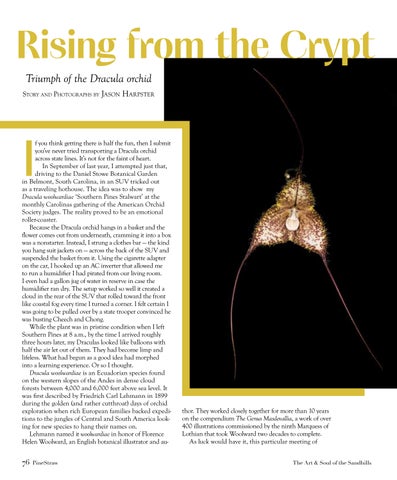Triumph of the Dracula orchid Story and Photographs by Jason Harpster
I
f you think getting there is half the fun, then I submit you’ve never tried transporting a Dracula orchid across state lines. It’s not for the faint of heart. In September of last year, I attempted just that, driving to the Daniel Stowe Botanical Garden in Belmont, South Carolina, in an SUV tricked out as a traveling hothouse. The idea was to show my Dracula woolwardiae ‘Southern Pines Stalwart’ at the monthly Carolinas gathering of the American Orchid Society judges. The reality proved to be an emotional roller-coaster. Because the Dracula orchid hangs in a basket and the flower comes out from underneath, cramming it into a box was a nonstarter. Instead, I strung a clothes bar — the kind you hang suit jackets on — across the back of the SUV and suspended the basket from it. Using the cigarette adapter on the car, I hooked up an AC inverter that allowed me to run a humidifier I had pirated from our living room. I even had a gallon jug of water in reserve in case the humidifier ran dry. The setup worked so well it created a cloud in the rear of the SUV that rolled toward the front like coastal fog every time I turned a corner. I felt certain I was going to be pulled over by a state trooper convinced he was busting Cheech and Chong. While the plant was in pristine condition when I left Southern Pines at 8 a.m., by the time I arrived roughly three hours later, my Draculas looked like balloons with half the air let out of them. They had become limp and lifeless. What had begun as a good idea had morphed into a learning experience. Or so I thought. Dracula woolwardiae is an Ecuadorian species found on the western slopes of the Andes in dense cloud forests between 4,000 and 6,000 feet above sea level. It was first described by Friedrich Carl Lehmann in 1899 during the golden (and rather cutthroat) days of orchid exploration when rich European families backed expeditions to the jungles of Central and South America looking for new species to hang their names on. Lehmann named it woolwardiae in honor of Florence Helen Woolward, an English botanical illustrator and au-
76 PineStraw
thor. They worked closely together for more than 10 years on the compendium The Genus Masdevallia, a work of over 400 illustrations commissioned by the ninth Marquess of Lothian that took Woolward two decades to complete. As luck would have it, this particular meeting of The Art & Soul of the Sandhills
